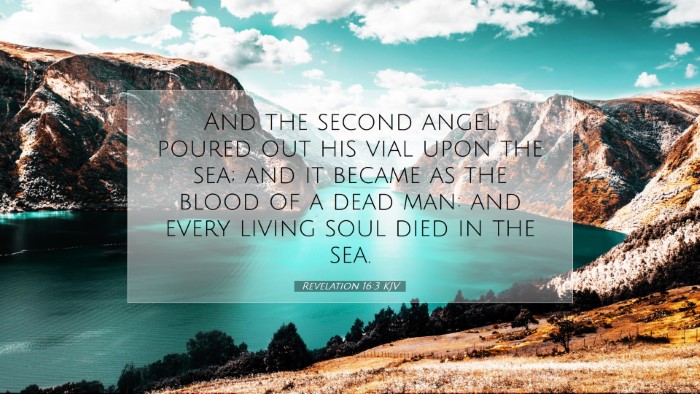Commentary on Revelation 16:3
Verse Text: "And the second angel poured out his vial upon the sea; and it became as the blood of a dead man: and every living soul died in the sea."
Introduction
The Book of Revelation, rich in symbolic language and prophetic imagery, portrays a series of judgments that fall upon the earth as part of God's ultimate plan for redemption and justice. Revelation 16:3 describes the second bowl judgment, where the sea is transformed into blood resembling that of a dead man. This vivid imagery invites reflection on divine judgment and the consequences of sin, as well as God's sovereignty over creation.
Insights from Public Domain Commentaries
Matthew Henry
Matthew Henry emphasizes the severity and stark symbolism of this judgment. He notes that the sea becoming as the blood of a dead man signifies total corruption and death, illustrating the devastating consequences of human rebellion against God. Henry draws attention to the theme of judgment as a progression from the previous judgments, highlighting that the death of everything in the sea reflects God's authority over life and death.
He also points out that the sea, often seen as a source of life and sustenance, becomes an agent of death. This transition serves as a sobering reminder of the devastation that comes from divine wrath against pervasive sin. The language of “every living soul dying” reinforces the totality of this judgment and serves to awaken humanity to the reality of divine authority.
Albert Barnes
Albert Barnes provides a thorough analysis of the implications of the second bowl judgment. He starts with a contextual understanding of the sea as a biblical symbol, often representing chaos and the nations. The transformation of the sea into blood is not only a literal act of divine retribution but also a symbolic representation of God's judgment upon nations that have turned away from Him.
Barnes articulates that this judgment serves as a portent of the final culmination of God's wrath against unrepentant humanity. He discusses the broader theological implications of this verse, emphasizing that the blood signifies a severing of relationships—between God and mankind, between the nations, and even between creation itself. Additionally, he notes that such judgments call humanity to reflect on their moral and spiritual state, inviting repentance and acknowledgment of God's sovereignty.
Adam Clarke
Adam Clarke takes an interpretative approach, focusing on the prophetic nature of the passage. He portrays the spillage of the second vial into the sea as an act that foreshadows the impending doom for those who are opposed to God's will. Clarke highlights that the phrase “blood of a dead man” serves to indicate both physical and spiritual death, representing the ultimate consequence of living contrary to divine principles.
He articulates the significance of the sea as a vital aspect of life, the removal of which poses questions about sustenance and existential threat. In Clarke’s view, this transformation symbolizes a world in chaos—a world where order and goodness are overshadowed by moral corruption and divine judgment. He also engages with the notion of ‘living souls’ and what it means for creation when it becomes subject to divine judgment, noting the totality of death that ensues as a clear sign of God’s disfavor.
Theological Reflections
This verse compels readers and scholars alike to consider the weight of divine justice and the holiness of God. The imagery of the sea turning to blood confronts humanity with the stark reality of sin's consequences and calls for an examination of one’s relationship with God. The devastation portrayed in this judgment serves as a contrast to God's grace, demonstrating the seriousness with which He takes sin.
Practical Applications
For pastors and theologians, Revelation 16:3 offers rich material for sermon development focused on themes of judgment and repentance. It challenges believers to reflect on their lives in light of God’s holiness and to prepare their hearts for the eventuality of divine accountability. Here are a few practical applications:
- Repentance: Encourage congregants to seek genuine repentance and reconciliation with God, recognizing the weight of sin.
- Awareness of Judgment: Teach the importance of understanding God’s justice and how sin has consequences, not only for individuals but also for nations.
- Hope in Redemption: While the passage describes judgment, it also points to a hope for redemption and restoration through Christ.
Conclusion
Revelation 16:3 is a powerful verse that encapsulates the themes of divine judgment and the seriousness of sin within the wider narrative of the Book of Revelation. The insights gleaned from public domain commentaries provide a multifaceted approach to understanding its significance, reminding us of the urgent need for repentance and awareness of God’s sovereignty over creation. As pastors, students, and theologians engage with this text, may it inspire a deeper reverence for God and a renewed commitment to live in accordance with His will.


